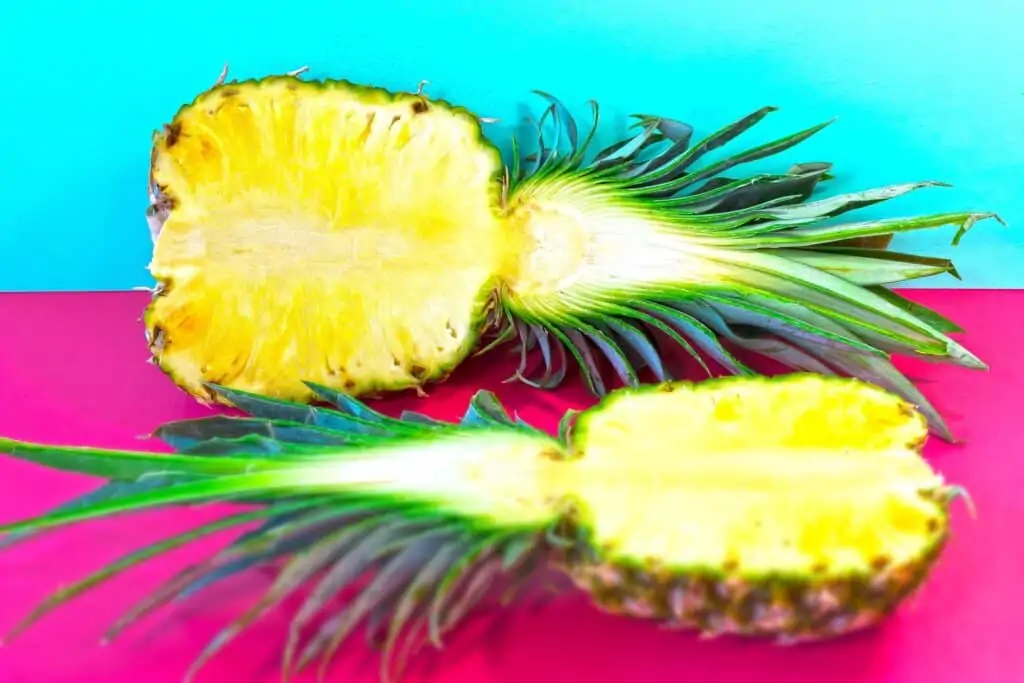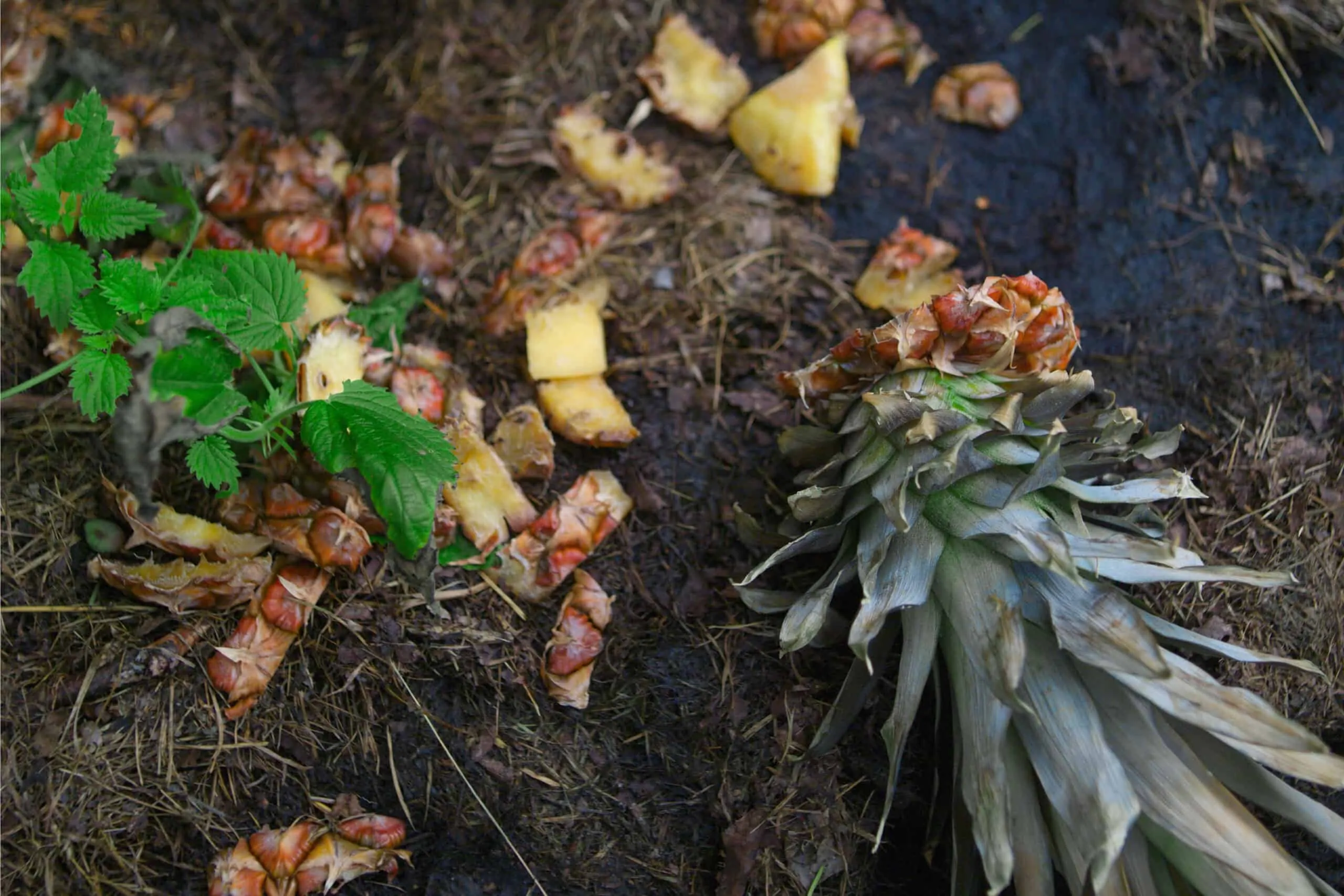As an Amazon Associate I earn from qualifying purchases.
Every time I stick something strange and new in my compost pile, I watch it like a hawk for the next week. If things seem slow, I’m always worried that I messed up the ratios, acidity, microbiota, etc.
At least, that used to be me.
The truth of the matter is, it’s pretty hard to mess up a compost pile. I mean, there was a time that I accidentally dumped in a load of shredded cardboard with labels and adhesive intact and then had to dig it all back out… but that’s a story for another time.
In order to shortchange my compulsive pile-watching, I find it much easier to just research whether an item is good for compost (or not), and then just throw it in and forget it. I’ll save you the trouble and just share with you the results of my research and experiments.
Pineapple is a great addition to compost. The high moisture content of the inner fruit ensures that it will break down quickly and provide nitrogen to your compost. The crowns, core, and skin can be composted as well but should be broken down manually beforehand to expedite the process.
The In-and-Outs of Composting Pineapple
If you’ve ever left a pineapple on your counter, you’ll know that one day it’s not quite ripe and the next day it’s way overripe. They seem to have about a three-hour window when everything is perfect. But what should you do if it gets gross (or you just aren’t going to eat it)? Well, it can be composted…with a few precautions.
Beyond the basic advantages of composting (waste reduction, amending soil, etc.), there are some advantages that are specific to pineapple:
High Moisture Content. Most piles need to have moisture added on a regular basis to keep the microorganisms growing and your pile decomposing. The addition of juicy fruits to your pile (such as pineapple) reduces the frequency of watering.
Infusion of Protein and Sugar. Nitrogen (protein) and Sugar (carbon) are the building blocks of any compost pile. When they are both present in the proper ratios, the little microorganisms responsible for decomposition multiply and speed up the entire process. Pineapple includes both nitrogen (mostly in the inner fruit) and carbon (mostly in the peel and stems), which are great for your pile.
With that being said, pineapple may not be the perfect addition. If you’re reading this article, it’s probably because you’re concerned about the acidity of your pineapple. After all, what happens if your pile gets too acidic? That’s bad, right?
Well, maybe.
As pineapple ages and ripens it actually gets less acidic. This is true of most fruits. As it decomposes, some acids and natural chemicals will remain – but most will be broken down by the time your compost is complete.
I have never manually adjusted the pH of my pile after adding small amounts of pineapple, and everything has worked out just fine.

If, however, you are adding pineapple to your compost pile consistently or in large amounts, you may want to consider neutralizing all of the acids that you are adding.
Tempering Pineapple Acid Using Hydrated White Lime
For the most rapid decomposition, the carbon-to-nitrogen ratio of your compost pile should be approximately 30 to one. Pineapples will increase the nitrogen content of your pile, so the idea here is to decrease the acidity of the fruit. The citric acid in pineapples will help preserve your composite pile as opposed to allowing for decomposition.
Anything you include in your compost containing acid will be preserved unless you take steps to reduce the acidity. You need to decrease the amount of citric acid to help your pineapple transform into compost faster.
One of your best options, when including decent quantities of pineapple into your compost, is adding hydrated white lime.
Hydrated white lime is a good solution for diluting the acid to a much lower level. It reacts directly with the acids in your compost pile regardless of their source, and it can easily handle the acid in your pineapple. This type of intervention is necessary to trigger and speed up the decomposition process.
Once the acidity has been decreased, the temporary preservation period will end. Your compost can then begin decomposition.
You can simply sprinkle some lime over the top of your pile at the same time you add pineapple, or shortly thereafter when you mix it. I typically add a highly-scientific “sprinkle,” which probably works out to about 1/2 cup per pineapple.
Remember: Parts of Pineapple Can Be Slow To Break Down
The flesh of a pineapple is called Ananas comosus. Though it’s mostly delicious, unfortunately, there is a large portion that is inedible. When you compost pineapple, you are transforming the spiky and stiff top and the spiny and tough rind into material rich in nutrients. You can use this in your garden for fertilizing your plants or improving the texture of your soil.
Pineapple is a fairly common kitchen scrap. Composting provides you with an opportunity to decrease the amount of garbage and waste filling up landfills every year. Pineapple peels contain a lot of nitrogen which helps ensure your compost is balanced. Unfortunately, pineapples also contain acidity and natural chemicals in the peels.
If added in excess this can kill certain microorganisms and worms, resulting in a much slower decomposition of your compost pile. Unless you cut your pineapple remains into small pieces, the peels will take a very long time to break down. This means you will have to wait much longer before your compost can be used. (Check out How To Know When Your Compost is Ready)
How To Compost Pineapple In 6 Easy Steps
If you are interested in learning how to compost pineapple, simply follow the steps detailed below.
1. Rinse And Prepare The Pineapple
Rinse your pineapple in the kitchen sink using a strong water spray. This is to make certain that any pesticide residue remaining is removed from the outside of the rind as it can harm your pile. Remove the top and rind from the edible flesh. You can store the fruit to enjoy later on. If the pineapple is past its prime, it’s fine the add the entire (chopped-up) fruit.
2. Manually Break Down What You Can
Chop the core, top, and rind of your pineapple into pieces between one and three inches in length. The smaller the pieces, the quicker they will break down. This is extremely important because the tough leaves and thick rind of a pineapple require more time to degrade than many other composted materials.
3. Store Or Consume Any Edible Parts
Store any uneaten or unused flesh and pineapple scraps in a compost container in your kitchen until you can add them to your compost bin or pile.
4. Mix The Pineapple Pieces Into Your Pile
Mix your pineapple scraps with any other green materials you have available including weeds, vegetable peels, or grass clippings until you have about the same amount of green material as brown. One of the necessary ingredients for successful composting is carbon. Toss in pine needles, hay, and dry leaves to create the right balance.
Make sure that when you add pineapple or other sugary fruits to your pile, you mix them in well. If they sit on top they will stink and attract lots of flies (not detrimental, just annoying).
5. Keep Your Pile Moist
Make certain your compost pile has even moisture throughout. Moisture is extremely important to help microorganisms break down organic materials. The final result is usable compost.
6. Balance Your Ratios & Temper Acidity
You want to make certain your compost pile has the correct nutrient balance. The next time you include materials rich in nitrogen in your compost pile or “greens” (which includes bits of leftover pineapple such as the leaves, skin, and flesh), throw in some “browns” as well. You should include three parts of materials rich in carbon or “browns,” such as paper or leaves, to one part of greens.
Can You Compost Pineapple Skin?
When you compost pineapple, keep in mind the skin is fairly tough. The top section of the fruit is even tougher. This means pineapple peels will not break down as quickly as the peels from other fruits such as a banana. Eventually, your pineapple skin will break down. If you want the decomposition to proceed faster, cut the top of your pineapple and the peel or skin into small pieces.
Conclusion
There are a lot of benefits when you compost pineapple and for composting in general. You add important nutrients to your soil. When you put your compost over existing soil, the nutrients added include nitrogen and carbon.
Plants require both of these nutrients for photosynthesis and growth. Your plants also use the water retained in the soil from your compost.
Composting provides your soil with valuable organisms and microorganisms, including fungi, decomposed organic material, bacteria, and protozoa. When these microorganisms are present in your soil, aeration is improved. This speeds up the process of composting, repels certain plant diseases, and converts nitrogen into a form usable for your plants.
Composting the waste from your yard and kitchen decreases the amount of trash you throw away by as much as 30 percent. This means a decrease in the amount of waste filling up landfills. Taking the time to compost correctly is a great way to be more eco-friendly, while also helping out your yard and garden!
Yes, organic material will eventually decompose when placed in a landfill. The process is just much slower than it is in your compost pile. Unfortunately, all of the nutrients produced by organic material placed in landfills will go to waste. Composting is not only a lot better for the environment, but it is also free. When you compost, you are not relying on the chemicals and fertilizers produced in factories.
So, at the end of the day, feel free to chuck your pineapple into your compost. Just chop it up first!

